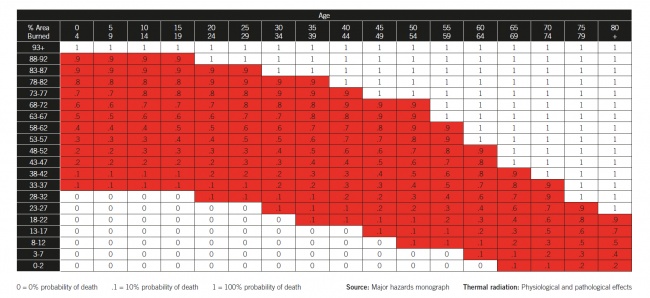BURN INJURY PREDICTION
The ROOTS range of products is renowned for the outstanding body burn wound results when exposed to a flash fire. We also use the same fabrics for our arc flash protection range because, in a way, this is also a burn wound prediction but from a different hazard source.
The goal of a burn injury prediction test combined with an open arc test is to seek prevention for wearers against 2nd-degree body burn injuries. However, the nature of both tests is completely different. The burn injury prediction test measures the level of protection of a fabric/garment during a 4-second flash fire at a temperature of approximately 1000°C. The open arc test reveals the amount of energy measured in cal/cm2 that is needed to result in 2nd° burn injuries or the point at which a fabric breaks open. With an open arc test temperatures can go up above 19,000°C; with a duration of between 0.5 and 1.5 seconds. Apart from high temperature, the plasma from the melted stainless steel electrodes is also released onto the fabric.
The difference between the level of protection between the 2-layer solution (ATPV 26,8 cal/cm2) and the 3-layer solution (ATPV 51.9 cal/cm2) can be best described as remarkable, keeping in mind that there is not a genuine 3rd layer (FR underwear) with an own ATPV rating of 4.8 cal/cm2. This extra thin layer combined with the air gaps offers extra protection that is needed for a substantial increase in the total calorific rating result.
Burn injury prediction on all product ranges
Although the relatively ‘new’ EN standard EN ISO 11612 (protective clothing – clothing to protect against heat and flame) is already a huge improvement as compared to the ‘old’ and less demanding EN531 it is still possible for garment makers to present products to the marketplace that are potentially unsafe.
Customers ask for garments conforming with EN ISO 11612 for instance. What few people are aware of is that it is already possible to get certification according to this standard after 5 cycles of washing and 1 cycle of drying, whereas the life cycle of the garment could easily reach 50 cycles of laundering. This is not told up front and one needs to dig deeper into the technical files behind the certificate to obtain this important information. This is relevant information because the use of Flame Retardant chemicals is a significant part of the cost price for flame retardant fabrics. Every single ROOTS EN ISO 11612 garment is certified against 50 cycles of washing and drying as opposed to the 5 cycles which is the standard.
Garment life cycle
Some garment makers claim in their neck label, or in the instruction manual a ‘Flame Retardancy for the life of the garment’ . At ROOTS we feel that this is more than inaccurate because EN ISO 11612 does not permit these claims. What is the life of the coverall? Is it 30 cycles, or 120 maybe? Claims like this give a false statement of safety; totally inappropriate and even immoral for a last line of defence safety product.
EN ISO 11612, the standard for limited heat and flame spread, offers garment manufacturers the ‘option’ to test their garment on a manikin’ during a 3-second flash fire. The test gives a skin burn prediction around the body whilst covered by a Flame Retardant garment. At ROOTS we realise that test is executed out on a coverall without contamination and being properly laundered, but it gives a reliable indication on the safety level one can expect from their Flame Retardant garment none the less.
For that reason, ROOTS takes this optional manikin test extremely seriously. ROOTS test every Flame Retardant garment design for 4 seconds on a manikin and by doing so, this extra second generates an extra 30% of heat energy. ROOTS garments are tested independently by BTTG (British Textile Technology Group) and we provide all of our existing and potential customers with BTTG test results.
Burn wound mortality chart
The image below shows a burn wound mortality chart. It indicates the relation between burn wounds and age. For example. Age 47 with a burn area of 24% results in a probability of death of 20%.

Below is a manikin test video comparison between a ROOTS coverall and a coverall from a major competitor. This video further shows how important the manikin test is. A lot of FR garment manufacturers claim that because their coverall is certified it is safe but that simply isn't always the case. As you can see below the ROOTS coverall would have protected someone very well in a case of a catastrophe while the coverall from the competitor would have lead to severe burns and possibly even death. Don't just trust someone's word for it when choosing an FR garment, trust your ROOTS.